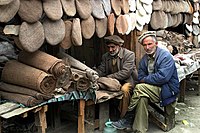


The Pakol or Pakul (Khowar: پاکول, Shina: پاکول, Persian: پاکسازی , Pashto: پاکسازی) is a soft, flat, rolled-up, round-topped men's cap, usually worn in Afghanistan and northern Pakistan. It is typically made of wool and found in a variety of earthy colours, such as brown, black, grey, ivory, or dyed red using walnut. The pakol is believed to have originated in Chitral,[1][2][3] or Gilgit-Baltistan in Pakistan.[4][5]
- ^ Chico, Beverly (2013-10-03). Hats and Headwear around the World: A Cultural Encyclopedia: A Cultural Encyclopedia. ABC-CLIO. p. 367. ISBN 978-1-61069-063-8.
Sometimes referred to as the chitral hat, its origins can be traced to northwest Pakistan, where it was initially made by tribal women for shepherds.
- ^ "From Alexander the Great to Ahmad Shah Massoud: A Social History of the Pakol | Afghanistan Analysts Network". 3 January 2014. Retrieved 2020-02-20.
Finally, Chitral's claim to the original ownership of the pakol is also supported by the fact that the place used to be at the center of the pakol's early "range of distribution", which at the beginning of the 20th century encompassed mainly Northern Swat, Gilgit, Hunza, and Nuristan.
- ^ "Grammar and vocabulary of the K̲h̲owâr dialect (Chitrâli)". digital.soas.ac.uk. 1895. p. 8.
The dress worn by most men consists of a black, brown, or grey homespun cap made in the shape of a bag and rolled up until it fits the skull.
- ^ Vogelsang, Willem (2006). "The Pakol: A Distinctive, but Apparently not so Very Old Headgear from the Indo-Iranian Borderlands". Khil'a. 2: 149–155. doi:10.2143/KH.2.0.2021290.
- ^ Biddulph, John (1880). Tribes of the Hindoo Koosh. Office of the superintendent of government printing. p. 74.
In Chitral, Wakhan and Sirikol the men wear very small, scanty turbans. In Gilgit, Astor, and the greater part of Yaghestan the rolled woollen cap mentioned by Mr. Drew is commonly worn. In the Shin caste, unmarried women are distinguished by a white cap, which is never worn by married Shin women.